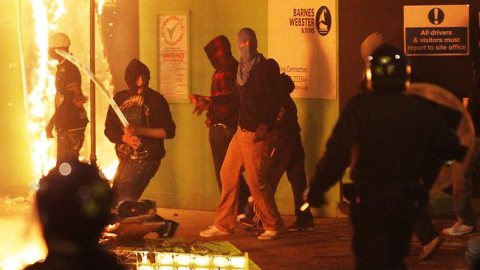Techno-Anarchy: Peaceful or Violent?

An excellent article by Bill Wasik in Wired UK discusses the role technology and connectivity play in the creation of unruly mobs (as opposed to the peaceful protests seen widely during the Arab Spring). Common lore holds that the use of the Blackberry Messenger (BBM) by rioters in London in the summer of 2011 accelerated mob behavior and helped the mob coordinate its violent looting. London mayor Boris Johnson was incredulous that BBM had not been shut down, calling it a tool that “weaponizes” mobile phones. In the article, Wasik crticially examines this theory by further examining the link between the technology and the behavior of the mob. When a mob has turned ugly, did the technology do more than just organize the crowd? Did it in fact bring out the base animal instincts in man?
The London riots began in protest of the killing of a 29 year old man by police during an arrest. However, the protests soon turned violent and took on a life of their own, degenerating into looting across Britain, causing millions of pounds of damage. Their use of Blackberry Messenger (BBM) allowed them to move in a coordinated fashion, quickly assembling and disassembling before police could corner and suppress them affectively (see news clip below). Wasik explains that the crowd might have been acting senselessly to the outside observer, but to each of them they were following a coherent ideology, logically following instructions and warnings that appeared on their phones. They were organized and in their connectedness and access to information, they found confidence and power. As Wasik writes, “A crowd’s power is amplified by the fact that its members can never really get separated. A crowd that’s always connected can never really be dispersed. It’s always still out there.” Such a crowd moves like a disciplined army unit even though it is dynamic and seems to move in and out like a flash (hence the term flash mob).
This view is supported by researchers like Clifford Stot of the University of Liverpool. Drawing on the pioneering work of Nobel prize winner Elias Canetti and his landmark Crowds and Power, Stot and other social psychologists believe that members of an unruly crowd find a common identity and act in a disciplined manner (even though the crowd as a whole appears completely chaotic). This theory runs counter to the traditional belief that violent crowds are a collection of individuals who are behaving recklessly because their anonymity in the throng encourages them to shed the imposed morals of human society. In fact, they act in the name of their evolving common identity and can become violent if the leadership and purpose change.
2011 witnessed many protests around the world, some violent and others peaceful. Technology clearly helps facilitate both types, its primary benefit being its organizing power and in allowing for crowds to exist even when they are not physically together.





